Dr Shaun Killen
 Contact details:
Contact details:
Room 206, Graham Kerr Building
Institute of Biodiversity, Animal Health & Comparative Medicine
College of Medical, Veterinary & Life Sciences
University of Glasgow
Glasgow
G12 8QQ
Tel.: 0141 330 3534
Fax: 0141 330 5971
E-mail: Shaun.Killen@glasgow.ac.uk
Also find information about my current and past research on my personal research website
Academic History
- Ph. D.: Memorial University of Newfoundland, Canada (Marine Biology)
- M. Sc.: Queen's University, Canada (Biology)
- B. Sc.: Queen's University, Canada (Honours; Biology)
Research Interests
My research focuses on how links between physiology and behaviour influence life-history strategies and trade-offs involved with foraging and predator-avoidance behaviours. I am also interested in the effects of environmental stress on animal behaviour, and the scaling of metabolic rate with body size in organisms and its relationship to ecology. Most of my work in these fields focuses on freshwater and marine fishes, and I have several specific research projects underway:
1) The role of individual physiological traits in collective animal behaviours
Links between physiological traits and behaviours have been demonstrated in a number of contexts.
Mullet Schooling in a swim tunnel
Interestingly, however, most of this work has been performed using individual animals, while in reality most animals live in groups. Focussing on fish schooling behaviour, this project investigates the role that the physiological traits of individuals play in shaping the behaviour of entire groups, and how environmental factors such as temperature and oxygen availability may affect this relationship.
This project is funded by a NERC advanced fellowship. A significant portion of this project is being conducted at the Northsea Oceanarium in Hirtshals, Denmark in collaboration with John Steffensen (University of Copenhagen). This facility contains an enormous schools of mackerel allowing us to study the behaviour of individual animals within the group.
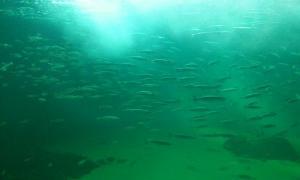 |
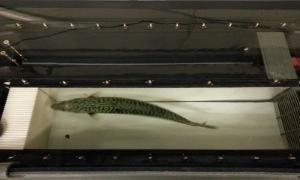 |
| Captive mackerel school at the Nordsøen Oceanarium in Hirtshals, Denmark | A mackerel swimming in a swim-tunnel, being measured for oxygen consumption at various swim speeds |
2) The causes and consequences of compensatory growth 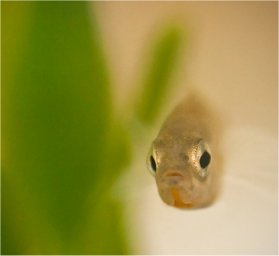 The theme of my previous NERC fellowship was compensatory growth in the three-spine stickleback Gasterosteus aculeatus and common minnows Phoxinus phoxinus. This project examined the consequences of compensatory growth on a wide range of behavioural traits including boldness, activity, and sociality. The project also included the first examination of the metabolic response to alarm substance in fishes, with growth compensated fish showing a decoupling of the physiological and behavioural responses to this cue as compared to controls. Growth compensated fish also displayed a preference for increased temperatures. This response may allow individuals to maximise growth but in the wild could translate to occupying shallower waters in shoreline areas with increased obviousness to aerial and terrestrial predators.
The theme of my previous NERC fellowship was compensatory growth in the three-spine stickleback Gasterosteus aculeatus and common minnows Phoxinus phoxinus. This project examined the consequences of compensatory growth on a wide range of behavioural traits including boldness, activity, and sociality. The project also included the first examination of the metabolic response to alarm substance in fishes, with growth compensated fish showing a decoupling of the physiological and behavioural responses to this cue as compared to controls. Growth compensated fish also displayed a preference for increased temperatures. This response may allow individuals to maximise growth but in the wild could translate to occupying shallower waters in shoreline areas with increased obviousness to aerial and terrestrial predators.
3) Links among energetic demand, aerobic capacity, and behaviour
Like most animals, fish face a constant trade-off between the need to search for food and the risk of being spotted by a predator. It has previously been hypothesized that individuals with a greater energy demand (i.e. a higher metabolic rate) may be more likely to risk being captured by a predator so that they can obtain more food. Similarly, increased aerobic capacity or locomotor ability may affect the balance of behavioural trade-offs or affect the ability to tolerate environmental stressors. I am examining these issues with a number of collaborators including Neil Metcalfe (University of Glasgow) David McKenzie (Université Montpellier II), Paolo Domenici (CNR, Italy), Stefano Marras (CNR, Italy), and Guy Claireaux (University of Brest).
4) Links between aerobic scope and immune function in fishes
The immune response is enormously important for defending animals against infection but the physiological costs of this response remain largely unknown. While there is some evidence that mounting an immune response increases energy expenditure, but effects on an individual’s aerobic capacity are unknown. Any aerobic capacity directed toward either of growth, digestion, locomotion, or reproduction results in a reduced ability to perform all others. Immune function has been completely overlooked in this context. Like immune function, aerobic scope can connect environmental factors with behaviour, life-history strategies and ultimately individual fitness, but a direct relationship between the immune system and aerobic scope has never been investigated. This project forms the basis of the PhD studies of Dana Weldon.
5) Thermal tolerance of invasive freshwater fishes
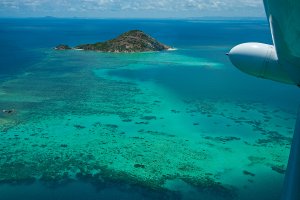 |
|
Lizard Island, Great Barrier Reef, Australia |
The sublethal effects of thermal stress on metabolic demand and aerobic capacity may affect the behaviour and geographical distribution of species. An increase in water temperature, for example, could allow species with wider thermal windows to gain a competitive advantage. In the context of global climate change, such species could expand their range into northern latitudes. Specifically, this project examines how the thermal tolerances of invasive species compare with native species and how this affects behaviour and ecological interactions. This project forms the basis of the PhD work being conducted by Julie Nati.
Other Recent and On-going Collaborations:
- Relationships between physiological traits and behaviour in juvenile coral reef fishes, with Mark McCormick and Jodie Rummer (James Cook University, Australia). This work is performed at the Lizard Island Research Station, on the Great Barrier Reef.
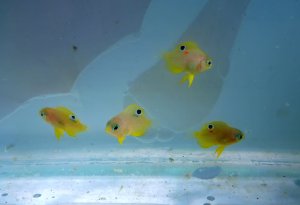 |
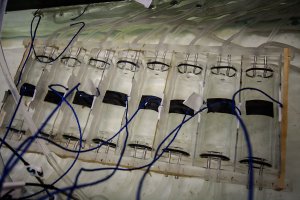 |
| Juvenile ambon damselfish, marked for identification with elastomere | Juvenile ambon damselfish in respirometers, being measured for metabolic rate |
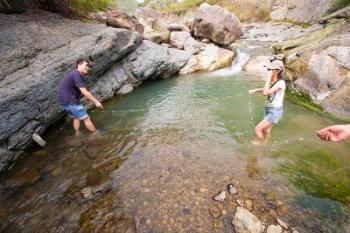 |
| Capturing fish with Prof. Shi-Jian Fu and students, from a stream outside of Chongqing, China |
- Individual variation in hypoxia tolerance and risky behaviours in chinese carp species, with Shi-Jian Fu (Chongqing Normal University, China) and Yu-Xiang Wang (Queen's University, Canada).
- The effects of growth rate selection on metabolic physiology and behaviour in fishes and implications for fisheries-induced evolution, with Robert Arlinghaus (Leibniz Institute of Freshwater Ecology and Inland Fisheries, Germany).
- The use of accelerometry tags to investigate the hydrodynamic benefits of schooling in fishes, with Lewis Halsey (University of Roehampton, UK), Julian Metcalfe and Serena Wright (CEFAS, UK).
- The effects of ecological factors on the scaling of metabolic rate with body size, with Doug Glazier (Juniata College, USA), David Atkinson (University of Liverpool, UK).
- The effects of habitat fragmentation and factors affecting patch departure decisions in juvenile Atlantic cod, with Bob Gregory (Department of Fisheries and Oceans, Canada), Paul Snelgrove (Memorial University, Canada).
Previous Research Projects
Metabolic Demand, Environmental Stress and Risk-Taking in Marine Fishes
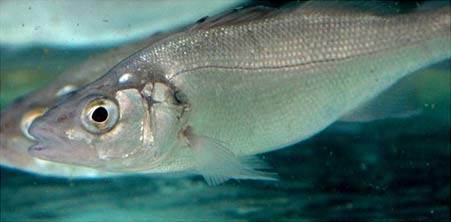 Like most animals, fish face a constant trade-off between the need to search for food and the risk of being spotted by a predator. An animal that spends all of its time hiding will be safe but probably won’t be able to find enough food to sustain itself. Conversely, an animal that is very active and exploratory may find more food but is also more obvious to predators. It has previously been hypothesized that individuals with a greater energy demand (i.e. a higher metabolic rate) may be more likely to risk being captured by a predator so that they can obtain more food. Stressful situations, such as a food shortage, could exacerbate this relationship between metabolic rate and behaviour.
Like most animals, fish face a constant trade-off between the need to search for food and the risk of being spotted by a predator. An animal that spends all of its time hiding will be safe but probably won’t be able to find enough food to sustain itself. Conversely, an animal that is very active and exploratory may find more food but is also more obvious to predators. It has previously been hypothesized that individuals with a greater energy demand (i.e. a higher metabolic rate) may be more likely to risk being captured by a predator so that they can obtain more food. Stressful situations, such as a food shortage, could exacerbate this relationship between metabolic rate and behaviour.
I previously examined these issues during a 2 year post-doctoral tenure at the Université Montpellier II, working in collaboration with Dr. David McKenzie. During this time I carried out a number of studies investigating individual variation in metabolic rate in marine fish species, and its consequences for risk-taking behaviour and responses to environmental stress (Killen et al. 2011, Proc. R. Soc. B; Killen et al. 2011, J. Anim. Ecol.). I also performed a series of studies examining the effects of feeding metabolism on fast-start escape behaviour in juvenile sea bass Dicentrarchus labrax, and the effects of hypoxia on risk-taking behaviour and predator susceptibility (in collaboration with Dr. Paolo Domenici, National Research Council, Italy).
Physiological and Behavioural Trade-offs During Early Ontogeny in Marine Fishes
I completed my Ph.D. at Memorial University of Newfoundland (St. John's, Newfoundland and Labrador, Canada) under the supervision of Drs. Joseph A. Brown and Kurt Gamperl.
The goal of my research was to better understand how changes in metabolism during early ontogeny can affect the foraging decisions and predator avoidance behaviour of larval and juvenile marine fish (Killen et al. 2007, Proc. R. Soc. B; Killen and Brown 2006, Mar. Ecol. Prog. Ser.; Killen et al. 2007, Mar. Biol.). This work revealed that young marine fish have a greatly elevated mass-specific metabolic demand compared to adults, and a greatly diminished aerobic scope. These metabolic challenges have a profound effect on the behavioural ecology of larval and juvenile fish.
For example, predator-induced foraging reductions are extremely costly for larval ocean pout Zoarces americanus and shorthorn sculpin Myoxocephalus scorpius, and frequent exposure to predators can lead to reduced growth and lipid storage. Further studies suggested that young lumpfish Cyclopterus lumpus alter their foraging strategy in response to certain environmental variables as a means to reduce activity and conserve space in their limited aerobic scope.
The Physiological Effects of Angling in Freshwater Fishes
My M.Sc. research was performed at Queen's University (Kingston, Ontario, Canada) under the supervision of Dr. Bruce L. Tufts.
This project examined the physiological effects of catch-and-release angling practices on walleye Sander vitreus, with the goal of identifying the causes of fish mortality following large-scale angling tournaments (e.g. Killen et al. 2003, N. Am. J. Fish. Man.; Killen et al. 2006, Tran. Am. Fish. Soc.). This project was also a chance to examine how the effects of numerous stressors (e.g. hypoxia, temperature, exercise, etc.) may interact to affect fish physiology. Overall, it was found that bouts of anaerobic metabolism (during the angling process, as well as during later air-exposure at the tournament weigh-in) were responsible for most of the physiological disturbance present in tournament fish (most notably, increased blood and muscle lactate and decreased stores of anaerobic fuels such as ATP, phosphocreatine, and glycogen).
The industrial partner for this research (Shimano Canada Ltd. - responsible for the live-release of fish caught in the largest professional angling tournament series in Canada) utilized the results of this work to develop new technology and practices for conducting angling tournaments and improving animal welfare.

